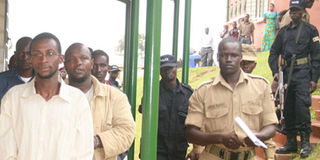Secret report exposes terror network’s operations in Kampala attack

FILE | NATION
Some of the suspects held in connection with the Kampala attack are led to Luzira prison in Uganda.
New details have emerged about what police and the intelligence services fear is a network of terrorists who pose a threat to Kenyans.
In a report shown to the Nation on Thursday, the authorities also revealed more information about how they believe the bombing attacks in Kampala on July 11 were planned and carried.
But the purpose of leaking the declassified information appeared to be to warn the country of the danger posed by elements of what they called al-Qaeda’s East African cell. Local al-Qaeda has merged with al-Shabaab, the Somali extremist group which claimed responsibility for the Kampala bombings.
According to the report, the cell has 17 officials, and two liason officers based in Nairobi and Beirut, providing the link to al-Qaeda.
The cell leader in East Africa, the report claims, is Mr Fazul Harun, an Afghanistan trained terrorist who has been involved in planning and executing all terrorist attacks against Kenya and on whose head the United States government has placed a $5 million bounty.
Anti-terror officials accuse Mr Abu Sahal of being Mr Harun’s deputy. The Nation could not reach Mr Sahal or independently verify the claims.
According to the report, terrorists in Somalia have been recruiting suicide bombers, intelligence and surveillance officers from Kenya, Uganda and Tanzania since 2007.
The recruitment was, with time, extended from North Eastern and Coast provinces to Central, Western, Nyanza and Eastern.
Some of the recruits have been arrested in connection with the Kampala bombings that claimed the lives of 76 people as they watched the World Cup finals on July 11, it claimed.
A day later, plans to stage similar attacks in Nairobi and Mombasa were scuttled after the suspects were arrested, according to the report.
The report also mentions a plan by al-Qaeda and al-Shabaab to disrupt the 2007 General Election but does not disclose the motive or how it would have been executed.
The explosives used in Uganda were assembled in Somalia, and possibly 10 vests laden with explosives were delivered to Mombasa in February.
“It has not been determined who bought the vests, the actual number and how they got into the country, but it’s likely they were brought in by sea,” it reads.
They were kept at a house in Mwembe Tanganyika by one of the Kenyans arraigned in court in Uganda, the report claims.
The report does not say how the vests were brought to Nairobi but reveals that a Landcruiser was bought which transported them from Nairobi to Kampala on May 8, entering Uganda at Malaba. One of the vehicle’s occupants, was arrested at the border “because he had been watch listed,” according to the report.
Two top lieutenants of al-Qaeda’s chief commander in East Africa organised his release.
So far, 38 suspects, among them nine Kenyans, have been arrested and are facing trial in Uganda.
Muslim leaders in Kenya have accused police and the intelligence services of illegally transferring Kenyans to Uganda and are demanding that they be returned and tried at home.




